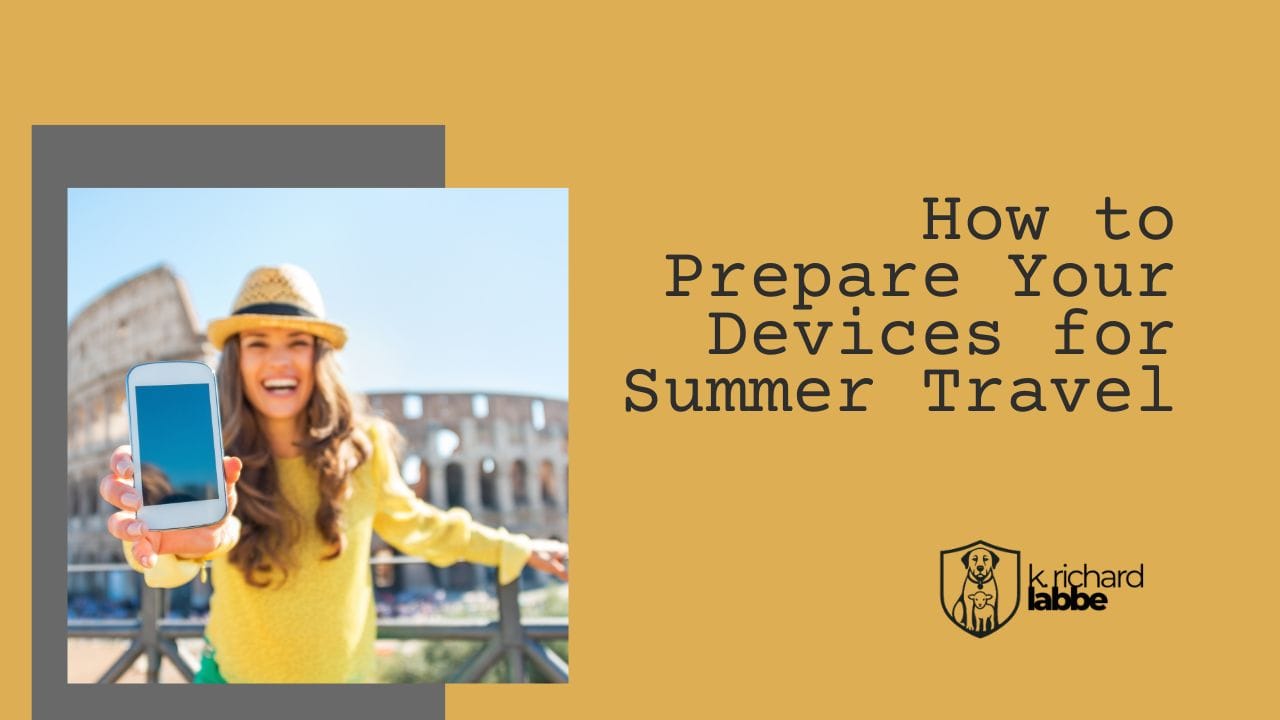How to Prepare Your Devices for Summer Travel
Simple, smart steps to keep your phone—and your data—safe on the road.

Traveling with your phone or tablet this summer?
Whether you’re heading across the country or just across town, unsecured Wi‑Fi, lost devices, and unfamiliar connections can expose your personal data to serious risk. This quick guide will help you secure your devices and protect your peace of mind—before you hit the road.
Why Travel Puts Devices at Risk
Your phone goes where you go—but that also means it:
- Can connect to open and unsecured Wi‑Fi
- May auto-sync with rental cars or hotel TVs
- Could be lost, stolen, or forgotten in the chaos of transit
- Might inadvertently share your location and usage data with third-party companies
You don’t need to fear every public hotspot or airplane seatback screen. But a few calm, thoughtful steps can dramatically lower your risk.
7 Smart Steps to Secure Your Device Before You Go
1. Set a Lock Screen (and Use It!)
Make sure your phone is protected with a PIN, fingerprint, or face unlock—and that it auto-locks within two minutes.
That simple screen can be the difference between inconvenience and identity theft.
Travel tip: Some travelers choose to disable Face ID or fingerprint unlock while abroad. A PIN or passcode may offer stronger legal protection in some high-risk or sensitive scenarios.
2. Enable “Find My Device” or Location Recovery
If your phone goes missing, you want a way to find it—fast.
- On iPhone: Go to Settings → [Your Name] → Find My → Find My iPhone
- On Android: Settings → Google → Security → Find My Device
These features let you:
- Track your phone’s location
- Play a sound to help locate it
- Lock it remotely or erase the data entirely if needed
3. Back Up Your Data
A lost phone is a pain. A lost phone without backups is a crisis.
Use iCloud, Google One, or your preferred service to back up:
- Contacts
- Photos and videos
- Notes, messages, and app data
Double-check that your backup completed before you leave.
4. Turn Off Auto-Connect to Wi‑Fi and Bluetooth
Public Wi‑Fi may be convenient—but it’s often insecure.
Disable “auto-join” settings so your phone doesn't connect to open networks without your approval. Do the same with Bluetooth.
Bonus: Consider using a VPN on public networks—especially for banking, shopping, or checking email. Our choice is Nord VPN (affiliate link).
5. Unpair from Rental Cars and Shared Devices
Rental cars can store more than just your tunes—they may save:
- Your call logs
- Your contacts
- Even your personal device name
Before you return the car, go to the Bluetooth settings and remove your device from the pairing list.
6. Enable Auto‑Wipe (Optional but Powerful)
Some phones allow you to erase your data after multiple failed passcode attempts.
- On iPhone: Settings → Face ID & Passcode → Erase Data
- On Android: Varies by device—search for “auto factory reset” or “erase after failed attempts”
Use this only if you have backups in place. It’s a strong safeguard if your phone is stolen.
7. Update Your Software
Install the latest iOS or Android system update before your trip.
Updates often include critical security patches that protect your device from known threats.
Extra Tips for Families, Caregivers & Tech-Savvy Travelers
- Consider labeling your phone with a name and backup contact on the lock screen or case
- Enable location sharing with a spouse, child, or parent if you’ll be traveling separately
- Use caution with tracking apps like Life360:
While helpful for family coordination, Life360 has been reported to share precise user location data with data brokers like Arity (a company affiliated with insurance pricing algorithms).
Unless you opt out, your location and driving behavior could be used to influence auto insurance rates
(The Markup).
→ Check your privacy settings and turn off “personal data sharing” where possible. - Use a privacy screen protector—especially in airports, cafés, or public places. It narrows the viewing angle and prevents “shoulder surfing.”
- Consider a “travel phone” with limited apps and no sensitive data for international or high-risk travel
- Log out of shared hotel tablets or public computers—and consider changing your password afterward
What If Your Phone Is Lost or Stolen?
You’ll be frustrated—but not helpless.
- Track it using Find My or Google’s Find My Device
- Contact your carrier to suspend the line or disable the SIM
- Report it to the police if you need a case number for insurance
- Wipe it remotely if it’s unrecoverable
If you’ve followed the steps above, you won’t lose your data or your peace of mind.
Travel Light. Travel Smart.
Preparing your device takes less than 15 minutes—but it can spare you weeks of stress and lost time if something goes wrong.
So before you leave:
- Set that passcode
- Update your system
- Pack your charger
- And enjoy your time away with confidence
We want you to be prepared, not paranoid.Good trips start with wisdom, not worry.
Stay safe. Be ready. Online and off.
Every effort has been made to ensure the accuracy and reliability of the information presented in this material. However, Labbe Media, LLC does not assume liability for any errors, omissions, or discrepancies. The content is provided for informational and educational purposes only and should not be considered professional advice. Viewers are encouraged to verify any information before making decisions or taking actions based on it.
